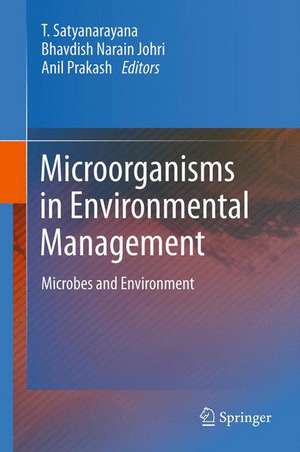Microorganisms in Environmental Management: Microbes and Environment
Editat de T. Satyanarayana, Bhavdish Narain Johri, Anil Prakashen Limba Engleză Hardback – 3 ian 2012
This survey of recent scientific progress in usefully applying microbes to both environmental management and biotechnology is informed by acknowledgement of the polluting effects on the world around us of soil erosion, the unwanted migration of sediments, chemical fertilizers and pesticides, and the improper treatment of human and animal wastes. These harmful phenomena have resulted in serious environmental and social problems around the world, problems which require us to look for solutions elsewhere than in established physical and chemical technologies. Often the answer lies in hybrid applications in which microbial methods are combined with physical and chemical ones. When we remember that these highly effective microorganisms, cultured for a variety of applications, are but a tiny fraction of those to be found in the world around us, we realize the vastness of the untapped and beneficial potential of microorganisms. At present, comprehending the diversity of hitherto uncultured microbes involves the application of metagenomics, with several novel microbial species having been discovered using culture-independent approaches. Edited by recognized leaders in the field, this penetrating assessment of our progress to date in deploying microorganisms to the advantage of environmental management andbiotechnology will be widely welcomed.
| Toate formatele și edițiile | Preț | Express |
|---|---|---|
| Paperback (1) | 1242.52 lei 6-8 săpt. | |
| SPRINGER NETHERLANDS – 23 aug 2016 | 1242.52 lei 6-8 săpt. | |
| Hardback (1) | 1246.47 lei 6-8 săpt. | |
| SPRINGER NETHERLANDS – 3 ian 2012 | 1246.47 lei 6-8 săpt. |
Preț: 1246.47 lei
Preț vechi: 1520.07 lei
-18% Nou
Puncte Express: 1870
Preț estimativ în valută:
238.54€ • 246.43$ • 198.53£
238.54€ • 246.43$ • 198.53£
Carte tipărită la comandă
Livrare economică 25 martie-08 aprilie
Preluare comenzi: 021 569.72.76
Specificații
ISBN-13: 9789400722286
ISBN-10: 9400722281
Pagini: 844
Ilustrații: XXI, 819 p.
Dimensiuni: 155 x 235 x 51 mm
Greutate: 1.27 kg
Ediția:2012
Editura: SPRINGER NETHERLANDS
Colecția Springer
Locul publicării:Dordrecht, Netherlands
ISBN-10: 9400722281
Pagini: 844
Ilustrații: XXI, 819 p.
Dimensiuni: 155 x 235 x 51 mm
Greutate: 1.27 kg
Ediția:2012
Editura: SPRINGER NETHERLANDS
Colecția Springer
Locul publicării:Dordrecht, Netherlands
Public țintă
ResearchCuprins
Foreword.- Preface.- 1. Halophiles: taxonomy, diversity, physiology and applications.- 2. Diversity of enteropathogens in river Narmada and their environmental and health implications.- 3. Insights into the genetic relationships between environmental and clinical strains of Yersinia enterocolitica biovar.- 4. Role of Microorganisms in remediation of contaminated soil.- 5. Role of microbiologically rich compost in reducing biotic and abiotic stresses.- 6. Exploitation of chitinolytic bacteria to chitin waste management.- 7. Diversity of microbial carbonic anhydrases, their physiological role and applications.- 8. Hepatotoxic and protease inhibitory metabolites in planktonic cyanobacteria collected from Central India.- 9. Calcium carbonate biomineralization in ferralitic, tropical soils through the oxalate-carbonate pathway.- 10. Bacterial degradation of xenobiotic compounds: An overview on metabolic pathways and molecular approaches.- 11. Molecular analyses of microbial activities involved in bioremediation.- 12. Microbial degradation of pyridine and its derivatives.- 13. Bioremediation, bioconversion and detoxification of organic compounds in pulp and paper mill effluent for environmental waste management.- 14. Bacteriophage based technology for disinfection of different water systems.- 15. Microbial mining of value added products from seafood waste and their applications.- 16. Management of heavy metal pollution by using yeast biomass.- 17. Management of Hospital Wastes with Potential Pathogenic Microbes.-18. Oleaginous fungi: a solution to oil crisis.- 19.Haloalkaliphilc bacteria and actinobacteria from the saline habitats: New opportunities for biocatalysis and bioremediation.- 20. Environmental impact from the use of bt toxin.- 21. Biodegradation of mono-aromatic compounds by bacteria.- 22. Bioremediation of arsenic from contaminated water.- 23. Metagenomics approaches in microbial bioremediation of metals and radionuclides.- 24. MicrobialConcrete, a wonder metabolic product that remediates the defects in building structures.- 25. Microbial degradation of cyanide and nitriles.- 26. Bioremediation of petroleum hydrocarbons in soils.- 27. Hairy root culture: a promising tool for phytoremediation studies.- 28. Biosurfactant-assisted bioaugmentation in bioremediation.- 29. Bioremediation of metals mediated by marine bacteria.- 30. Microbial denitrification and its implications in the marine system.- 31. Genomic technologies for environmental bioremediation.- 32. Coalmine drainage pollution and its bioremediation.- 33. Poultry waste management using microorganisms.- 34. Cyanoremediation: a green clean technology.- 35. Microbial decolorization of colored industrial effluents.- Subject Index.
Recenzii
From the reviews:
“The present volume is edited by prominent leaders in the field and written by well-known scientists. It comprises 35 chapters, a preface and an index, and covers many topics in environmental pollution. … This book is very useful for all readers belonging to different scientific domains, from undergraduate to specialist level.” (Ioan I. Ardelean, Romanian Journal of Biochemistry, Vol. 49 (2), 2012)
“The present volume is edited by prominent leaders in the field and written by well-known scientists. It comprises 35 chapters, a preface and an index, and covers many topics in environmental pollution. … This book is very useful for all readers belonging to different scientific domains, from undergraduate to specialist level.” (Ioan I. Ardelean, Romanian Journal of Biochemistry, Vol. 49 (2), 2012)
Textul de pe ultima copertă
Microbes and their biosynthetic capabilities have been invaluable in finding solutions for several intractable problems mankind has encountered in maintaining the quality of the environment. They have, for example, been used to positive effect in human and animal health, genetic engineering, environmental protection, and municipal and industrial waste treatment. Microorganisms have enabled feasible and cost-effective responses which would have been impossible via straightforward chemical or physical engineering methods. Microbial technologies have of late been applied to a range of environmental problems, with considerable success.
This survey of recent scientific progress in usefully applying microbes to both environmental management and biotechnology is informed by acknowledgement of the polluting effects on the world around us of soil erosion, the unwanted migration of sediments, chemical fertilizers and pesticides, and the improper treatment of human and animal wastes. These harmful phenomena have resulted in serious environmental and social problems around the world, problems which require us to look for solutions elsewhere than in established physical and chemical technologies. Often the answer lies in hybrid applications in which microbial methods are combined with physical and chemical ones. When we remember that these highly effective microorganisms, cultured for a variety of applications, are but a tiny fraction of those to be found in the world around us, we realize the vastness of the untapped and beneficial potential of microorganisms. At present, comprehending the diversity of hitherto uncultured microbes involves the application of metagenomics, with several novel microbial species having been discovered using culture-independent approaches. Edited by recognized leaders in the field, this penetrating assessment of our progress to date in deploying microorganisms to the advantage of environmental management andbiotechnology will be widely welcomed.
This survey of recent scientific progress in usefully applying microbes to both environmental management and biotechnology is informed by acknowledgement of the polluting effects on the world around us of soil erosion, the unwanted migration of sediments, chemical fertilizers and pesticides, and the improper treatment of human and animal wastes. These harmful phenomena have resulted in serious environmental and social problems around the world, problems which require us to look for solutions elsewhere than in established physical and chemical technologies. Often the answer lies in hybrid applications in which microbial methods are combined with physical and chemical ones. When we remember that these highly effective microorganisms, cultured for a variety of applications, are but a tiny fraction of those to be found in the world around us, we realize the vastness of the untapped and beneficial potential of microorganisms. At present, comprehending the diversity of hitherto uncultured microbes involves the application of metagenomics, with several novel microbial species having been discovered using culture-independent approaches. Edited by recognized leaders in the field, this penetrating assessment of our progress to date in deploying microorganisms to the advantage of environmental management andbiotechnology will be widely welcomed.
Caracteristici
Covers broader aspects of the role of microbes in environmental management The chapters will be written with special reference to the developments in environmental microbiology and microbial technologies in solving environmental pollution problems in India, although global aspects will be discussed Also covers aspects such as microbial concrete, bacteriophages in disinfection of water systems, metagenomics in bioremediation, bioremediation of arsenic and several others










